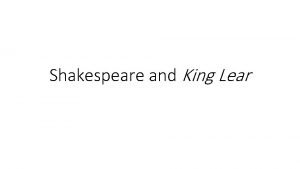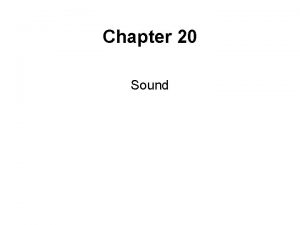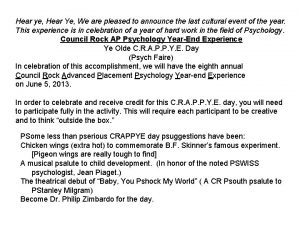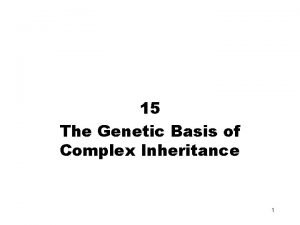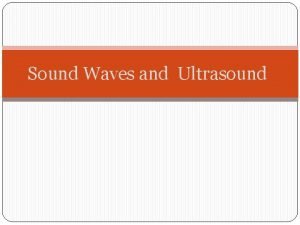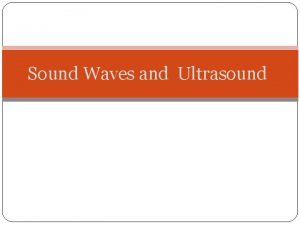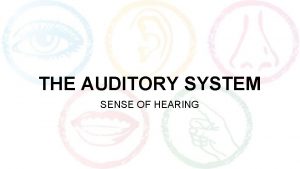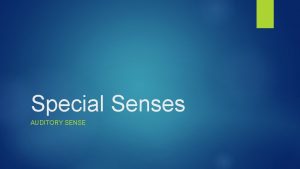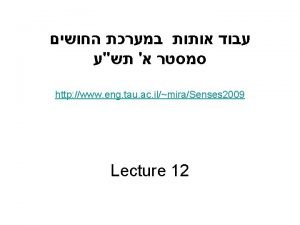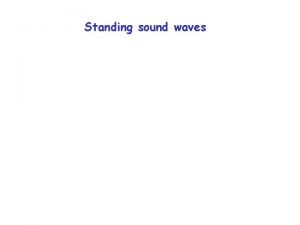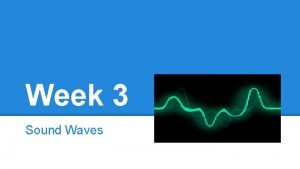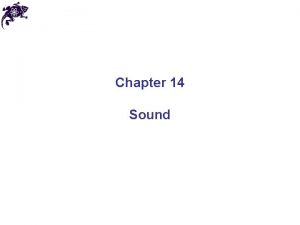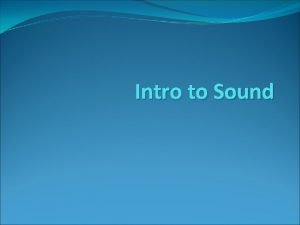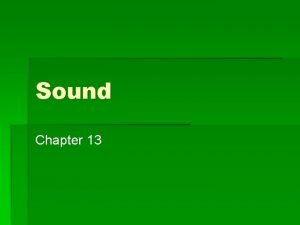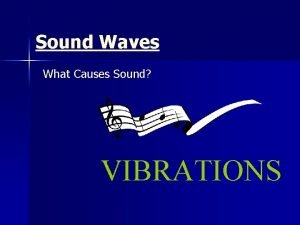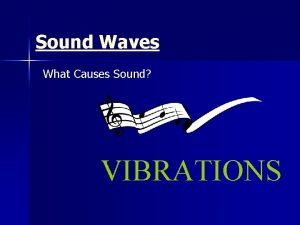Hearing Our auditory sense We hear sound WAVES
















- Slides: 16

Hearing Our auditory sense

We hear sound WAVES • The height of the wave gives us the amplitude of the sound. • The frequency of the wave gives us the pitch if the sound.

The Intensity of Some Common Sounds Decibels are the measuring unit for sound energy


Transduction in the ear • Sound waves hit the eardrum then hammer then anvil then stirrup then oval window. • Everything is just vibrating. • Then the cochlea vibrates. • The cochlea is lined with mucus called basilar membrane. • In basilar membrane there are hair cells. • When hair cells vibrate they send impulses up the auditory nerve to the thalamus. It is all about the vibrations!!!

Pitch Theories Place Theory and Frequency Theory

Place Theory • The pitch we hear depends on the place where the cochlea’s membrane is stimulated • So some hairs vibrate when they hear high and other vibrate when they hear low pitches.

Frequency Theory • The pitch we hear depends on the rate of nerve impulses traveling up the auditory nerve • All the hairs vibrate but at different speeds.

How We Locate Sounds

Types of Hearing Loss Conduction Deafness § Hearing loss caused by damage to the mechanical system that conducts sound waves to the cochlea (such as a damaged eardrum) • You can replace the bones or get a hearing aid to help. Sensorineural Deafness • The hair cells in the cochlea get damaged. • Loud noises can cause this type of deafness. • NO WAY to replace the hairs. • Cochlea implant is possible.

Touch • Receptors located in our skin. • Essential to Development – babies develop faster if stimulated by skin contact • Four skin senses – pressure, warmth, pain, cold – Simultaneously stimulating warm and cold produces a burning sensation! • Pain is a good thing! It tells us something is wrong with our Did You Know? Reducing or eliminating one sense body can improve others! This is why when kissing, lovers minimize distraction and increase their touch sensitivity by closing their eyes!

Gate Control Theory of Pain • The spinal cord contains a neurological “gate” that blocks pain signals or allows them to pass through A Naughty Question to Think About: If a person had the top of their spinal cord severed and their genitals were touched, would they still experience sexual excitement?

Taste (Gustation) • We have bumps on our tongue called papillae. • Taste buds are located on the papillae (they are actually all over the mouth). • The more taste buds you have, the more sensitive your taste! • Sweet, salty, sour, bitter, umami • Taste enabled our ancestors to survive!

• Olfaction: sense of smell. • Fragrance molecules reach receptors at top of nose brain’s olfactory bulb limbic system (memory and emotion) • Smell is strongly linked to taste and emotion! • Humans can detect about 10, 000 odors • Women and young adults have best sense of smell • ONLY SENSATION THAT DOES NOT GO TO THE THALAMUS FIRST Smell

Kinesthetic Sense • The system for sensing the position and movement of individual body parts • Vision plays a role! Without the kinesthetic sense you couldn’t touch the button to make copies of your buttocks.

Vestibular Sense • Tells us where our body is oriented in space. • Our sense of balance. • Located in our semicircular canals in our ears. • Guided by cerebellum • Cirque du Soleil balancers
 Thou nature art my goddess
Thou nature art my goddess The sound waves that most humans cannot hear are
The sound waves that most humans cannot hear are The wave chapter 13
The wave chapter 13 Is echolocation transverse or longitudinal
Is echolocation transverse or longitudinal Light is electromagnetic radiation true or false
Light is electromagnetic radiation true or false How are rainbows made
How are rainbows made Matthew 13
Matthew 13 Hear ye, hear ye announcement examples
Hear ye, hear ye announcement examples Dominant genetic variance
Dominant genetic variance Narrow sense heritability vs broad sense heritability
Narrow sense heritability vs broad sense heritability Spirit break out heaven come down
Spirit break out heaven come down Compare and contrast p waves and s waves using venn diagram
Compare and contrast p waves and s waves using venn diagram Do electromagnetic waves require a medium
Do electromagnetic waves require a medium Mechanical and electromagnetic waves similarities
Mechanical and electromagnetic waves similarities Mechanical waves vs electromagnetic waves venn diagram
Mechanical waves vs electromagnetic waves venn diagram Mechanical wave
Mechanical wave Surface waves and body waves
Surface waves and body waves
